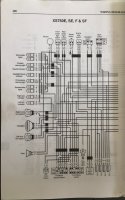Hey all,
So i had my bike out of commission for a few days to do some basic engine work, mostly to do with the carbs and boots and fuel lines, but then i also took the opportunity to do a few simple re routing of wires going to tail lights and signals. Didn't change anything, just relocated the wires and tied them here or there to keep them out of the way.
When i hooked everything back up, i turned the key one click and got no lights whatsoever on gauges. So i turned it back off and disconnected negative and went through all the wires and found some dodgy connections and tightened them. I also noticed that one wire connection was a bit exposed and had been resting against some of the frame. So then i checked all the fuses to see if i had blown one upon startup. All the fuses are good.
So i hook up the battery again and turn the key, but this time i get some lights on the gauges. However, when i go to actually fire up the button, i get no reaction at all. No sound or click or anything. So again i disconnect the battery and check out the throttle wiring. In the past, the ground wire between the engine run switch and frame had a bad connection and needed to be fastened better and then the run button worked. So i thought maybe this was the case again but after trying a few times it didn't do anything.
I get all lights/accessories. horn, signals. But no ignition activity when pressing the button.
So i looked throughly through all wiring on as much of the bike as possible, in particular where i was rerouting some wires. I checked all of them multiple times, and found some weak connections so recreated them.
However, i found something that's not attached. I don't know there it is supposed to go though. Please see attached picture. It is a yellow wire with a green stripe, and it's taped up on the end. I looked in the service manual wiring diagram for my bike and didn't find anything yellow-green that this made sense to be other than to do with turn signals. I don't know why it's not connected. I just got this bike a month or so ago, and hadn't noticed this wire. When i saw it today, i saw it tucked down pretty low in there so hadn't noticed it until digging around.
Any ideas what could be causing the ignitition/run to do nothing at all when the button is pressed? Could i have maybe blown something when trying to fire it up? Any ideas what this yellow/green wire might be?

So i had my bike out of commission for a few days to do some basic engine work, mostly to do with the carbs and boots and fuel lines, but then i also took the opportunity to do a few simple re routing of wires going to tail lights and signals. Didn't change anything, just relocated the wires and tied them here or there to keep them out of the way.
When i hooked everything back up, i turned the key one click and got no lights whatsoever on gauges. So i turned it back off and disconnected negative and went through all the wires and found some dodgy connections and tightened them. I also noticed that one wire connection was a bit exposed and had been resting against some of the frame. So then i checked all the fuses to see if i had blown one upon startup. All the fuses are good.
So i hook up the battery again and turn the key, but this time i get some lights on the gauges. However, when i go to actually fire up the button, i get no reaction at all. No sound or click or anything. So again i disconnect the battery and check out the throttle wiring. In the past, the ground wire between the engine run switch and frame had a bad connection and needed to be fastened better and then the run button worked. So i thought maybe this was the case again but after trying a few times it didn't do anything.
I get all lights/accessories. horn, signals. But no ignition activity when pressing the button.
So i looked throughly through all wiring on as much of the bike as possible, in particular where i was rerouting some wires. I checked all of them multiple times, and found some weak connections so recreated them.
However, i found something that's not attached. I don't know there it is supposed to go though. Please see attached picture. It is a yellow wire with a green stripe, and it's taped up on the end. I looked in the service manual wiring diagram for my bike and didn't find anything yellow-green that this made sense to be other than to do with turn signals. I don't know why it's not connected. I just got this bike a month or so ago, and hadn't noticed this wire. When i saw it today, i saw it tucked down pretty low in there so hadn't noticed it until digging around.
Any ideas what could be causing the ignitition/run to do nothing at all when the button is pressed? Could i have maybe blown something when trying to fire it up? Any ideas what this yellow/green wire might be?
Last edited:



